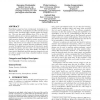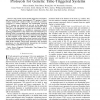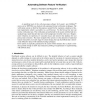529 search results - page 76 / 106 » Model checking detectability of attacks in multiagent system... |
ACSAC
2010
IEEE
13 years 5 months ago
2010
IEEE
Smartphone usage has been continuously increasing in recent years. Moreover, smartphones are often used for privacysensitive tasks, becoming highly valuable targets for attackers....
FORTE
2008
13 years 9 months ago
2008
Network-based fuzz testing has become an effective mechanism to ensure the security and reliability of communication protocol systems. However, fuzz testing is still conducted in a...
TDSC
2011
13 years 2 months ago
2011
Abstract— We present on-line tunable diagnostic and membership protocols for generic time-triggered (TT) systems to detect crashes, send/receive omission faults and network parti...
AGENTS
2000
Springer
13 years 12 months ago
2000
Springer
This paper presents a knowledge approach to designing team training systems using intelligent agents. We envision a computer-based training system in which teams are trained by pu...
BELL
2000
13 years 7 months ago
2000
A significant part of the call processing software for Lucent's new PathStar access server [FSW98] was checked with automated formal verification techniques. The verification...



